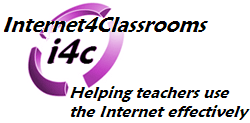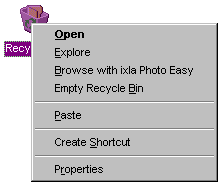
 |
Links for K-12 Teachers | Assessment Assistance | On-Line Practice Modules | Daily Dose of the Web
Using the Start Menu and other Desktop items
Task bar- The gray strip that runs along the bottom of your screen contains useful several items. At the far left end is the Start menu button which will be explained below.
- Active Window button - Each window that is open will be represented by a button on the toolbar. Only one of them will be an active window. That button will appear to be lighter that the other buttons and will look as if it is three dimensional extending below the level of the rest of the Task bar
- Inactive Window button - All Inactive window buttons will be the same color gray as the rest of the Task bar They will look as if they are three dimensional extending above the level of the rest of the Task bar You may make an inactive window active by putting your mouse pointer on the button and gently clicking one time with the button on the left side of the mouse.
- Time - Place your mouse pointer directly over the time but do not click.
- Windows will display the date.
- With your mouse pointer directly over the time gently click two quick times to open the Date/Time control panel
- Sound Control - The yellow speaker is the Sound icon. Notice that mine has a red circle over it with a diagonal slash. That is the universal symbol for No. That means that the sound control panel has been set to Mute, to be silent. To adjust sound, place the tip of your mouse pointer on the middle of the yellow speaker icon and gently click one time with the left mouse button. A pop-up control panel give you the opportunity to change your computer volume quickly.
- Empty area - Between the Active window and the system tray (that is what they call that area to the far right), there is an empty gray area. If you put the tip of your mouse pointer in the empty gray area and gently click one time with the right mouse button, the following pop-up menu appears:
The Start Menu - The image below is what you would see if you put your mouse pointer over the Start button and gently click one time with the left mouse button. This image is clickable. Put the tip of your mouse pointer on an item and gently click one time with the left mouse button. Caution: Not all of the items in the window are clickable.
Programs - The common way to get to any program or application stored on your computer is to slide your mouse pointer up to the programs menu, then select an application which you want to work in. This is also where you will go to get to the built-in items that you learned about earlier. You are not required to click on this area of the menu, but you may. Whether you click or not, move your mouse pointer quickly to the right into the list of applications. In the window above you have a clue that there will be more choices displayed when your mouse pointer moves to that area. See it? The triangle pointing to the right indicates that more selections can be found in Programs, Favorites, Documents, Settings, and Find.
Documents - The Find menu of most applications will display the most recent documents saved while working in that application. This menu choice displays the last fifteen documents that were saved in any application on your computer. This is a quick and easy way to get back to a document to continue work. Caution: This only works if the document has not been moved to a new location. If the document was saved to a floppy disk, and that floppy is no longer in the computer, then the document will not be found.
Find - "I saved it! I know I did!" I know you have either said that, or heard someone else say that. Whenever you save a document, the Save window indicates the location that the document was saved to. New computer users don't always notice where their masterpiece was saved. That is what this menu choice is for. Think about that for a minute. Yes, that's right! Everyone has trouble, at one time or another, remembering exactly where a document was saved.
Steps for using the Find menu choice:
- Using the left mouse button, gently click one time on Start
- Slide your mouse pointer up to Find and gently click one time
- Slide your mouse pointer to the right so that it points to Files or Folders and gently click one time
- Remember some part of the file name and type that in the Named: box
- Check the Look in: box and make sure you are searching the entire computer, not just a directory or disk.
Help - No, you are not the only one that needs Help from time to time. The people that wrote Windows knew that and have provided a very large index of topics. The first few times you use Windows Help you will probably want to use the Contents tab as you see in the window below. If you have an idea as to what you are looking for, use the Index tab
Shut Down - If your computer is not frozen you should shut your computer down using the Shut Down menu. Do not automatically press the Enter key when you see the Shut Down Windows dialog box pop-up.
Windows remembers the last thing that you did with this dialog box. If the last thing you did was Restart and you press the Enter key you will Restart not Shut down. Develop a habit of carefully reading the dialog boxes that pop up.
Start Button - This is the button you use to access all of the choices described above.
Inactive Window - Make an Inactive window Active by clicking on the button in the Task bar
Desktop Items - The visible image that covers your entire screen is known as your Desktop. On your desktop are several small images called icons. You may also have icons that appear to be file folders. Each time you save something to the Desktop, an icon is added there. Some of the icons are known as Shortcuts. Those are small instructions which tell your computer where a larger program is located. To find out about each of the elements displayed below, click on the item.
My Computer - This icon displays the main components of your computer. You can open any of the items in this window to further examine the components of your computer.
For Example: put the tip of your mouse pointer on the 3 1/2 Floppy (A:) icon and gently click two quick times on the icon to see what is in your floppy disk.
My Documents - Unless you instruct Window otherwise, the standard (default) place where your documents are saved is in My Documents. As you create more documents (known as files) on your computer you may wish to save them in other places. As you are getting accustomed to using your computer My Documents is a good place to save things.
Internet Explorer - Double clicking on this icon will launch the Internet browser named Internet Explorer.
Netscape Communicator - Double-clicking on this shortcut will launch the Internet browser named Netscape Communicator. Notice the bottom corner of the Netscape icon has a small white box with a black arrow pointing up to the right. That symbol signifies that the icon is a shortcut rather than an application icon. It is OK to throw away a shortcut. However, it is not OK to throw away an application icon.
Recycle Bin - Speaking of throwing things away, this is the place there they go when you delete them from anywhere except a floppy disk. Items deleted from a floppy disk are immediately discarded from your computer. Anything else you delete goes to the Recycle Bin. Items in the Recycle Bin may be removed from the bin, or the Recycle Bin may be emptied. To empty the bin, place the tip of your mouse pointer on the bin icon and gently click one time with the right mouse button. When the pop up menu appears, slide down to Empty Recycle Bin and gently click one time with the left mouse button. The Recycle Bin has been emptied, those items are gone from your computer (unless someone like the FBI is looking at your hard drive - Yeah, it left traces of itself which can be discovered by someone who really knows how to look.)
Moral: don't plan something illegal on your computer ;-)
Task - Use the index component of Help to find out what ScanDisk is used for. If you are not sure what to do next, review that section of this page before you try to accomplish the task.
Mouse | Windows | Desktop | Built-In | Formatting a Disk | Saving | Keyboard
 Custom Search
Custom Search
Visitors since November 2000